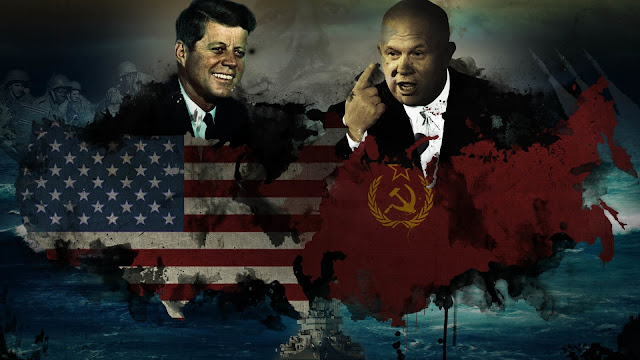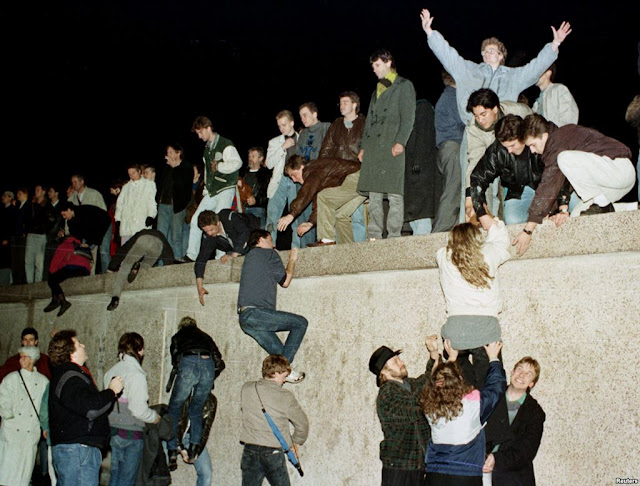The crises of the Cold War.
In 40 years, the Cold War is a series of tensions and calm on the international scene between the two major. Russian and US clash interposed by country. This is why we speak of cold war, even if sometimes the risk of direct conflict between the two great was real.
In Europe.
In Europe, Germany becomes a permanent tension instead.
In 1948, the Russian decided blockade the western part of Berlin, which, although located in Russian territory is shared between the four winners. The US retaliated by setting up an airlift to supply the city. Before the US firm, Stalin decided to lift the blockade a year later.
In 1949, Germany was divided into two:
To the west, the pro-American R.F.A.
To the east the R.D.A. pro-Communist. But the Berlin situation does not change.
In 1961, the communist Germany decides to surround the western part of Berlin a wall to prevent the escape of Berlin from the east to the free world. In 1963, US President Kennedy went to West Berlin to denounce the "wall of shame". This wall became the symbol of the Cold War.
In the rest of the world.
In Asia, China became communist in 1949 (Mao Zedong). From 1950-1953, US troops involved alongside South Korea against North Korea supported by China and the USSR
In 1962, the Russian install nuclear missiles in Cuba led by a Communist (Fidel Castro). Americans take the threat very seriously, and impose an ultimatum to the Russians who are backtracking.
From 1964-1975, the US intervene militarily in Vietnam to prevent the Vietcong guerrillas from Vietnam communist North to take power in the southern capitalist party. This is the only American military defeat to date.
In the Middle East, Israel supported by the US and Arab countries backed by the USSR engaged in many conflicts all won by Israel.
The scrutinizing of the squares and the fall of socialism.
The contestation of the squares.
From the 60s, the two noteworthy are tested in their own particular camp. Toward the east, the prominent uprisings in Hungary in 1956 and Czechoslovakia in 1968 against socialism, yet Soviet troops mediate to restore request.
Toward the west, General de Gaulle denies US mastery, pulls back from NATO in 1966 and drove an autonomous remote approach.
A specific tranquility between the two coalitions.
The comrade pioneer Khrushchev talks about "quiet concurrence" between the two squares and a specific facilitating moves (eg establishment of a hotline called "hot line" in the middle of Moscow and Washington)
At last, in 1975, are marked the Helsinki Accords, which build up an atmosphere of confidence. This settlement accommodates the admiration of outskirts acquired from the Second World War, to determine struggle calmly and to regard human rights.
Be that as it may, the pressure is becoming again in the 80s with the instance of Euro-rockets. The Soviets introduced atomic rockets SS 20 in Eastern Europe, indicated the West. The Americans countered by introducing their Pershing rockets in Germany, guiding towards the USSR. It is the disappointment of years of demilitarization arrangements 60. What's more, the Soviet Union has an approach of extension in Africa, Latin America and Afghanistan.
the fall of socialism.
It was sudden and startling. In 1985, Mikhail Gorbachev, is executing an approach of changes to advance socialism towards majority rule government and rearrange the economy. These changes fall flat and Gorbachev is prevalent abroad than in the USSR.
These change endeavors have the impact of waking difficulties in the nations of Eastern Europe under comrade principle for a long time. Poland and Hungary are the first to transparently dismiss socialism and to cut the Iron Curtain.
On 09.11.1989, the Berlin Wall was crushed and the two Germanys rejoined in 1990 are.
In 1991, after a fizzled upset by socialist restriction to Gorbachev, Yeltsin banned socialism. The Soviet Union imploded and 14 states have their free.





























No comments:
Post a Comment